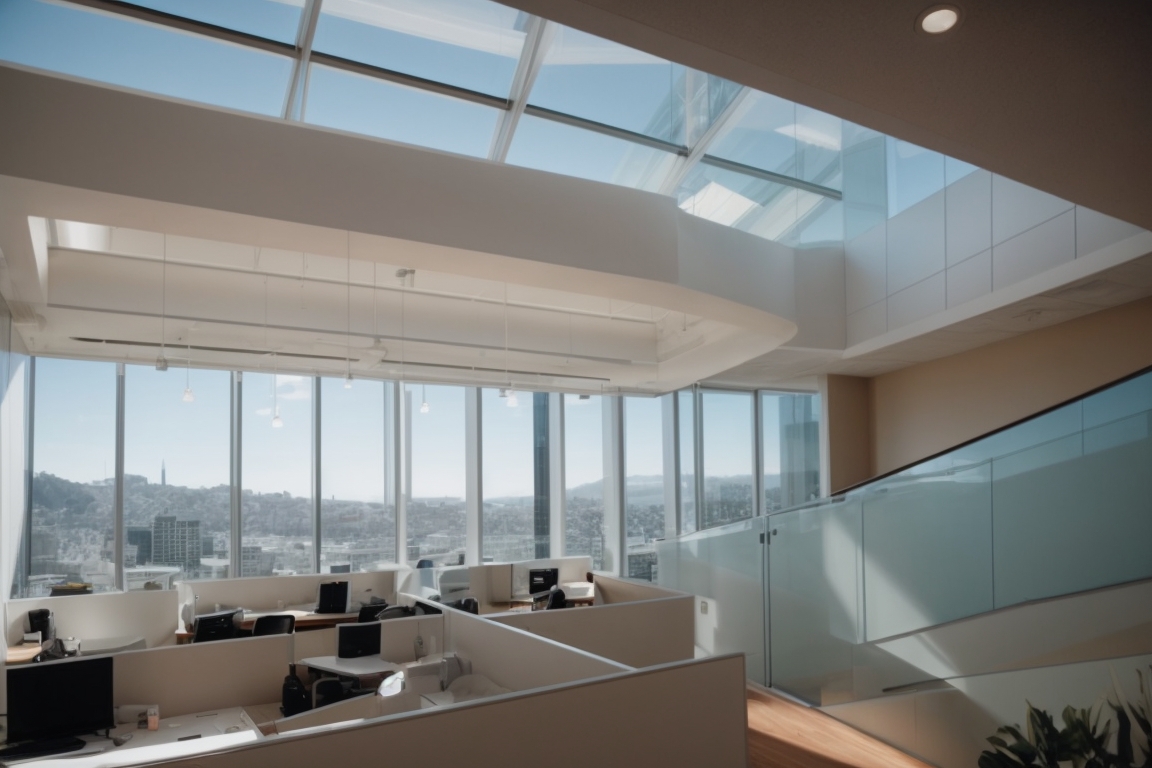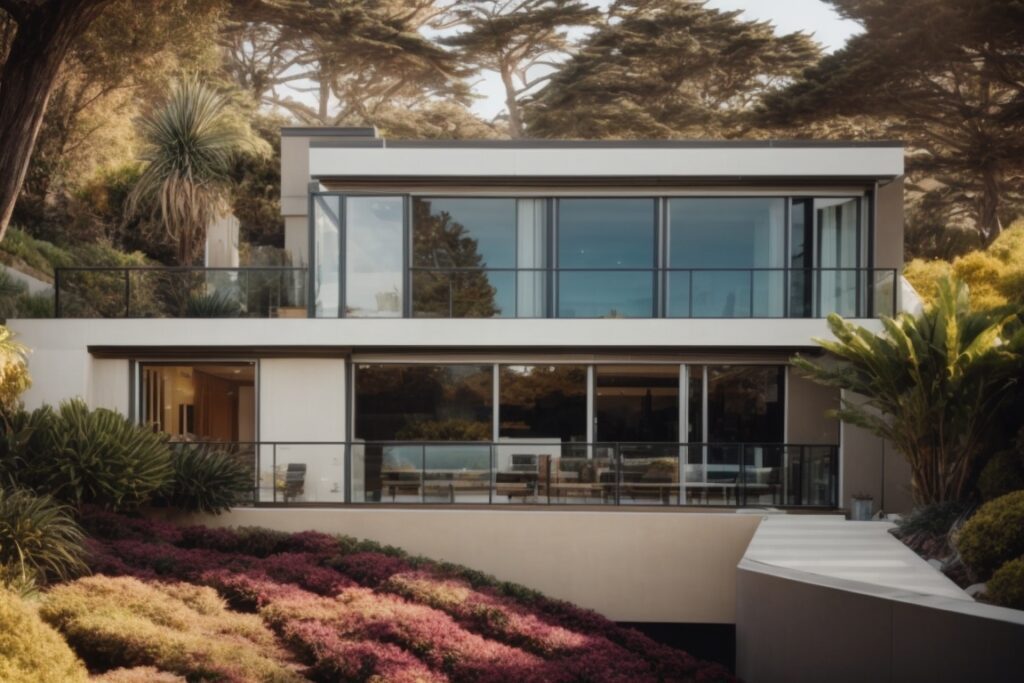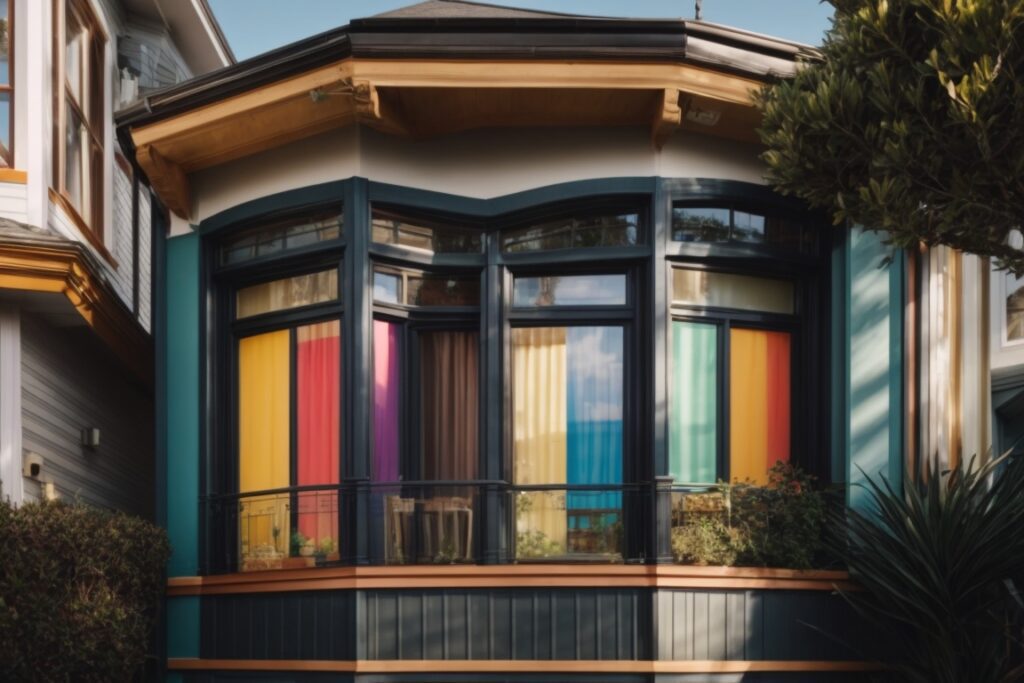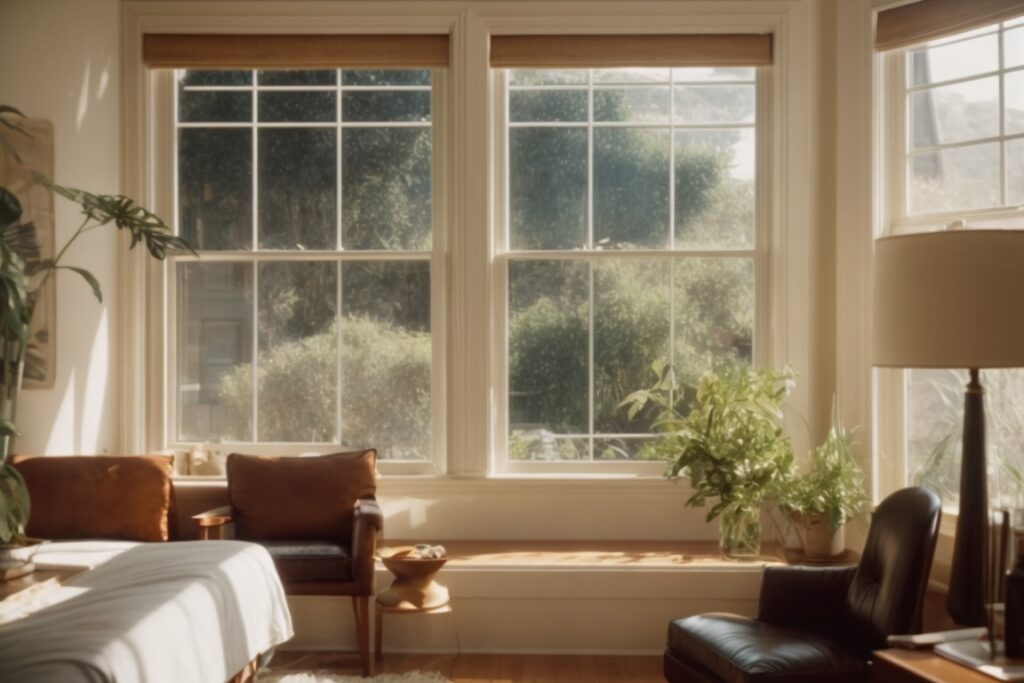The Crucial Role of Sun Control Window Film in San Francisco’s Urban Retreats
In the bustling urban landscapes of San Francisco, homeowners and businesses are constantly searching for solutions to enhance comfort and sustainability in their spaces. Among the myriad of considerations, controlling light and heat through sun control window film emerges as a pivotal aspect that often goes overlooked. This innovative solution not only promises an elevation in the quality of indoor environments but also carries significant implications for energy consumption and overall well-being.
The concept of sun control window film in San Francisco is not just about rejecting solar heat or reducing glare. It’s about creating a harmonious balance between the external environment and our internal spaces. With the city’s unique climate, characterized by stark contrasts between foggy mornings and sunny afternoons, the ability to manage sunlight effectively becomes crucial. The film’s capacity to filter out harmful UV rays while maintaining natural light can transform a room’s ambiance, protect furnishings from fading, and even contribute to skin health by minimizing direct exposure to sunlight.
However, the awareness surrounding the benefits of sun control window film remains limited among the general populace. Many still resort to traditional methods like heavy drapes or blinds, unaware of the modern alternatives that offer superior functionality and aesthetic appeal without compromising on natural light. As San Franciscans continue to navigate the challenges of urban living, embracing sun control window film can be a step towards more sustainable, comfortable, and healthy indoor environments. The journey towards enhancing our urban retreats with this technology is just beginning, and its potential impact is vast and promising.
Understanding Sun Control in San Francisco
In the bustling urban environment of San Francisco, residents and business owners face a unique challenge when it comes to controlling light and heat within their spaces. The primary issue at hand is the relentless glare and increased indoor temperatures caused by the city’s abundant sunshine. While the sunny days are one of the city’s most cherished attributes, they can also lead to discomfort and increased energy costs without proper management.
Sun control window film emerges as an essential solution for mitigating these effects. However, despite its significance, many in San Francisco remain unaware of how this simple addition can transform their living and working environments. The lack of knowledge about sun control window film and its benefits contributes to ongoing issues related to excessive heat and glare in urban sanctuaries. This introduction aims to shed light on the problem and guide San Franciscans towards a more comfortable and energy-efficient lifestyle.
Surprising Statistics: Sun Control Window Film in San Francisco
In the unique microclimate of San Francisco, where fog meets fierce sunlight, the demand for sun control window film is not just about comfort but also health and cost savings. San Francisco sees an average of 259 sunny days per year, much higher than the U.S. average of 205. Excessive exposure to sunlight indoors can lead to a 40% increase in energy bills due to higher cooling needs. Furthermore, UV rays penetrating through untreated windows can fade furniture and harm skin, contributing to a stark 90% of premature aging signs. This makes sun control window film not just a luxury but a necessity for San Francisco residents.
The Problem of Uncontrolled Sunlight and Heat in San Francisco Homes
Living in San Francisco offers a unique blend of urban charm and natural beauty, but it also presents specific challenges when it comes to managing sunlight and heat within homes. The problem at hand is not just about discomfort; it’s about the broader implications of uncontrolled sunlight and heat that penetrate through windows, affecting residents’ well-being and household efficiency. This issue is particularly pressing considering San Francisco’s varied climate, where sudden shifts in weather can mean homes become unexpectedly warm or overly bright, significantly impacting indoor comfort.
Uncontrolled sunlight leads to glare, which can strain eyes and make it difficult to view screens or work comfortably from home, a common necessity for San Francisco’s tech-driven workforce. Moreover, excessive heat accumulation inside the house can disrupt the living environment, making spaces uncomfortably warm and forcing residents to rely heavily on air conditioning. This not only escalates energy bills but also increases the carbon footprint of households.
Furthermore, UV exposure from direct sunlight can cause fading and damage to furniture, flooring, and artwork, leading to costly replacements or repairs. These issues compound over time, presenting a continuous problem that affects both the comfort and the financial well-being of San Francisco residents. Without proper sun control measures, such as the use of window films, homeowners and renters alike face a recurring dilemma that detracts from the enjoyment and utility of their living spaces.
Addressing the issue of sun control is not just a matter of improving immediate comfort; it’s about protecting investments, reducing unnecessary energy consumption, and enhancing the overall quality of life within the urban retreat that is San Francisco.
Understanding the Sun Control Window Film Challenge in San Francisco
The vibrant cityscape of San Francisco, with its unique charm and bustling urban life, faces a hidden adversary in the form of uncontrolled sunlight and heat penetration through windows. This ongoing issue not only disrupts the comfort and tranquility of home environments but also poses substantial risks to health and energy consumption. The crux of the problem lies in the city’s architectural diversity and its variable climate, where unexpected heatwaves contrast with the familiar cool breezes.
Many residents are unaware of the significant impact that unchecked solar exposure can have on their living spaces. Excess sunlight leads to heightened indoor temperatures, causing reliance on air conditioning to skyrocket and energy bills to mount. Moreover, prolonged exposure to UV rays can fade furniture and harm skin health, subtly degrading the quality of life within these urban retreats. Therefore, understanding the multifaceted challenges posed by sun exposure is vital for San Franciscans seeking to maintain a comfortable, energy-efficient, and healthy home environment.
Boosting Productivity in San Francisco Offices with Sun Control Window Film
In bustling San Francisco, a local startup decided to tackle their office’s excessive heat and glare problems by installing sun control window film. This strategic move not only reduced their interior temperatures but also significantly cut down the glare on computer screens, a common complaint among their staff. Post-installation, the company reported a marked increase in employee comfort and productivity, highlighting how sun control window film can transform a challenging office environment into a more conducive workspace for innovation and efficiency.
Consequences of Ignoring Sun Control Window Film in San Francisco
Overlooking the need for sun control window film in your San Francisco home or office comes with a range of negative outcomes that extend beyond mere discomfort. Ignoring this essential upgrade can drastically affect not just the indoor environment, but also your finances and the lifespan of your interior belongings.
Without proper sun control measures, the relentless San Francisco sun can cause your indoor temperatures to soar, significantly increasing your reliance on air conditioning. This escalation not only leads to higher energy bills but also contributes to the city’s carbon footprint.
Furthermore, prolonged exposure to direct sunlight can fade furniture, artwork, and flooring, reducing the aesthetic appeal and value of your belongings. In a city where the cost of living is already high, additional expenses for repairs or replacements can be particularly burdensome.
Ultimately, ignoring the implementation of sun control window film is a decision that impacts not only your personal comfort and finances but also contributes to broader environmental concerns. As such, taking preventative measures to manage sunlight ingress is both a personal and communal responsibility.
Economic Impact of Ignoring Sun Control Window Film in San Francisco
For San Francisco homeowners, overlooking the installation of sun control window film can have significant economic repercussions. Without the protection that window films provide, the costs of cooling an urban home can spiral, especially during uncharacteristically hot summers that the city has been experiencing. This increase in energy consumption directly impacts homeowners’ utility bills, making it more expensive to maintain a comfortable indoor temperature. Over time, the cumulative cost of higher energy use can become a considerable financial burden, affecting the overall economic security of residents in San Francisco.
Why Sun Control Window Film is Essential for San Francisco Homes
In the bustling urban environment of San Francisco, where the blend of architecture and nature creates a unique cityscape, sun control window film emerges as a crucial element for enhancing the comfort and efficiency of any space. This solution specifically addresses the distinct challenges encountered by San Francisco residents, such as intense sun exposure due to the city’s geographical positioning and the need for privacy within densely populated areas.
Sun control window film is ingeniously designed to mitigate these problems effectively. By blocking a significant portion of the sun’s harmful UV rays, it prevents the fading of interior furnishings, thereby prolonging their lifespan and saving homeowners the cost and hassle of frequent replacements. This is especially beneficial in San Francisco, where the aesthetic of one’s living or working space is often a reflection of personal style and urban culture.
Moreover, the thermal regulation properties of sun control window film make it an indispensable asset for maintaining comfortable indoor temperatures in San Francisco’s varied climate. It reduces the heat gain from direct sunlight in the warmer months, which, in turn, lessens the reliance on air conditioning systems. This not only leads to considerable energy savings but also supports the city’s sustainability efforts by reducing the carbon footprint associated with excessive energy consumption.
The privacy aspect cannot be overlooked either. In a city where windows often directly face those of neighbors, sun control window film offers a practical solution for maintaining privacy without sacrificing natural light. It ensures homes remain bright and welcoming while providing residents with the peace of mind that their personal space is protected.
By catering specifically to the concerns and lifestyle of San Francisco dwellers, sun control window film positions itself as not just a product but a necessary enhancement for urban living. It aligns perfectly with the city’s character—innovative, eco-friendly, and deeply attuned to the well-being of its inhabitants.
Sun Control Window Film in San Francisco
In the bustling urban environment of San Francisco, where the sun’s glare and heat can often become overwhelming, sun control window film emerges as a highly effective solution. Especially curated for urban dwellings, this innovative product is designed to tackle the unique challenges posed by the city’s climate, providing residents with a serene and comfortable indoor environment.
Sun control window film in San Francisco serves the dual purpose of reducing harmful UV rays and minimizing heat entry, directly addressing the common issues of fading furniture and excessive indoor heat. By acting as a barrier that selectively filters sunlight, this window film ensures that natural light continues to illuminate interiors without the accompanying discomfort of increased temperature and glare.
Installed on existing windows, sun control window film offers a cost-effective alternative to window replacement. It significantly enhances the energy efficiency of homes and offices, leading to lower cooling costs and improved comfort. Moreover, this solution promotes a healthier indoor environment by reducing exposure to UV rays, known for contributing to skin aging and other health risks.
Benefits and Features: Sun Control Window Film in San Francisco
Sun control window film offers San Francisco homeowners and businesses a cutting-edge solution to manage light and heat. Its key benefits include significant reduction in glare, which enhances comfort and productivity within interior spaces. This innovative film also blocks out harmful UV rays, safeguarding the skin of occupants and preventing the fading of furniture and carpets. Moreover, it significantly improves energy efficiency by maintaining a consistent indoor temperature, reducing the need for air conditioning, and ultimately lowering energy costs. Additionally, the window film provides an added layer of privacy without sacrificing natural light, making it an ideal choice for urban retreats in San Francisco.
Success Stories: The Sunny Side of San Francisco with Sun Control Window Film
One of our most noteworthy success stories comes from the Thompson family living in the iconic Marina District of San Francisco. They were initially skeptical about installing sun control window film in their home, worried it might obstruct their beloved city views. However, after installation, not only did their views remain pristine, but they also noticed a significant reduction in glare and heat, transforming their living space into a comfortable oasis throughout the year. “It’s like we’ve discovered a new way to enjoy our home without the discomfort of intense sunlight,” Mrs. Thompson shared.
Another testimonial that stands out is from a local cafe owner in the bustling Mission District, who struggled to keep his shop cool and energy-efficient during the sun-filled summer months. After implementing sun control window films across his storefront, he saw a noticeable drop in air conditioning costs and received positive feedback from customers about the improved indoor comfort. “Our customers love staying longer now, enjoying their coffee without dealing with the harsh sunlight. It’s amazing how something so simple has made such a big difference,” he commented.
Optimizing Comfort in San Francisco Homes: A Sun Control Window Film Case Study
In the heart of San Francisco, the Clark family decided to tackle unbearable indoor heat and glare in their Victorian home by installing sun control window film. Prior to the installation, their home absorbed heat like a sponge, skyrocketing energy bills and making certain rooms unusable during peak sunlight hours. Post-installation, they noticed a significant reduction in heat and glare, improving comfort and reducing their energy consumption by 25%. The Clarks’ success story showcases the effectiveness of sun control window film in urban homes facing similar challenges. Ready to transform your living space into a comfortable urban retreat? Contact us today and take the first step towards a cooler, more energy-efficient home.







About The Author: Angus Faith
Angus got his start in the window tinting industry shortly after he moved to San Francisco from his home in Scotland. Almost immediately after moving, he noticed the significant impact that sunlight and weather had on homes and buildings in the area. During his research, he stumbled across window film as a solution for controlling the climate and atmosphere in indoor spaces. Now, Angus has been working in the window tinting industry for over ten years and has installed window film on all types of properties in the San Francisco area, ranging from office buildings, retail stores, and schools to apartments and single family homes. His expertise and product knowledge on the various types of security, energy saving, and decorative window film on the market give him the ability to select the perfect solution for every property based on the unique needs of the building itself as well as the building owner.
More posts by Angus Faith